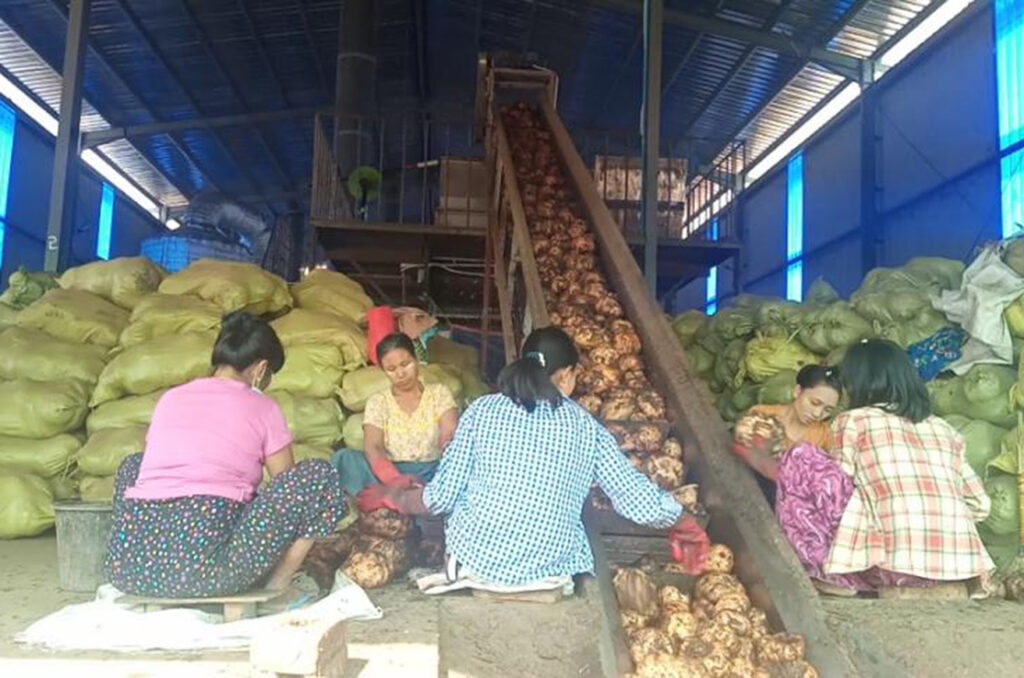21 Jan
Shwenayon elephant foot yam factory in Pakokku Township is purchasing fresh elephant foot yams from Mindat Township of southern Chin State at over K1,700 per viss (a viss equals 1.6kg).
Before the coronavirus pandemic, the price of fresh yams reached a maximum of K2,300 per viss. This year, it fell to K1,700.
“It is only two years that Shwenayon factory was established in Pakokku Township. It was developed on 1.45 acres of land, with an estimated capital of K400 million. The factory purchases about 14,000 visses of yams from Mindat Township, Chin State at K1,725 per viss. The fresh yams are dried and processed into powder to be exported to Japan. China market prefers the slices. It offers K12,500 per viss. Japan buy the dried elephant foot yam powder at US$9 per viss.
“The factory has stored around 500,000 viss of fresh yams for now. The elephant foot yam cultivation in Chin State will end in January-February. If China calls for more demand, we will keep buying the yams. Some growers sell the fresh elephant foot yams with some impurities, such as soil and root.
Moreover, some bring them after rinsing with water. We have to process the yams with driers not to decay,” said U Nyi Nyi Lwin, the Shwenayon factory owner. I have exported elephant foot yams to Japan and China for the last 13 years, cooperating with the Chin State supplier. Earlier, the country has no yam drying factory. Therefore, we bought the sun-dried yams only. The yam drying factories were established in Myanmar five years ago. The dried foot yam processing includes rinsing, cutting, chopping, slicing and drying. The full capacity of yam production is 20 tonnes per day, he continued.
“Japan and China produce them by adding value to snacks, noodles and medicines and so on. It is low-fat food and has many health benefits. There is valued-added production of elephant foot yams in Myanmar as well. However, the yams are not that popular in the country as local people do not know the health benefits of elephant foot yams,” he elaborated.
A grower from Panpa village of Mindat Township stressed: “I usually sell them in Mandalay. This year, the yam factories from Mandalay city rarely buy them. That is why I contacted with Shwenayon factory from Pakokku Township and sold them at K1,725 per viss. It incurred some loss compared to last year.
Yams produced in Chin State are getting a higher price than those from other regions. They have better quality and taste, said traders. Myanmar’s elephant foot yams are primarily purchased by China, Japan, and the Republic of Korea. Japan offers higher prices than China for yams.
There are currently about ten factories for drying elephant foot yams in Myanmar.
Elephant foot yam production has become a lucrative business. Therefore, value-adding technology is crucial for boosting elephant foot yam production and expanding its market, according to the Myanmar Fruit, Flower, and Vegetable Producer and Exporter Association.
According to the association, Myanmar is mostly exporting raw yam, and value-added products made from yam will help the market grow in the long term. Myanmar is only producing semi-processed yam at present.
Elephant foot yams are the main product of Chin State, where they are cultivated on over 8,800 acres of land. The Kanpetlet, Mindat, and Matupi townships produce about 1 million visses (a viss equals 1.6 kg) of elephant foot yams. Elephant foot yams can be planted across the country. In addition to Chin State, yams are being grown in Kayin, Mon, and Shan states, and Taninthayi and Bago regions.
Myanmar exported 4,200 tonnes of elephant foot yams in the 2014-2015 financial year, 1,300 tonnes in the 2015-2016FY, and 20,000 tonnes in the 2016-2017FY, according to the data from the Ministry of Commerce.
Salai Ko Kee (IPRD)(Translated by Ei Myat Mon)



